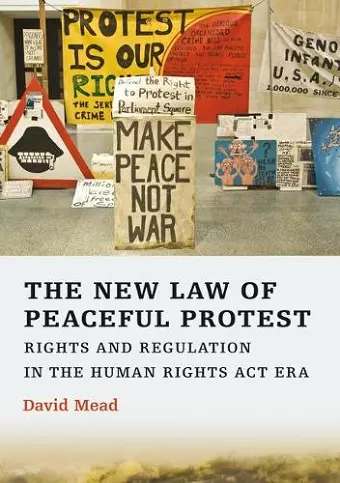The New Law of Peaceful Protest
Rights and Regulation in the Human Rights Act Era
Format:Paperback
Publisher:Bloomsbury Publishing PLC
Published:6th Apr '10
Currently unavailable, and unfortunately no date known when it will be back

The right to demonstrate is considered fundamental to any democratic system of government, yet in recent years it has received little academic attention. However, events following the recent G20 protests in April 2009 make this a particularly timely work. Setting out and explaining in detail the domestic legal framework that surrounds the right of peaceful protest, the book provides the first extensive analysis of the Strasbourg jurisprudence under Articles 10 and 11 of the European Convention on Human Rights, offering a critical look at recent cases such as Ollinger, Vajnai, Bukta, Oya Ataman, Patyi and Ziliberberg, as well as the older cases that form its bedrock. The principles drawn from this case-law are then synthesised into the remainder of the book to see how the right of protest enshrined in the Human Rights Act 1998 now operates. The five central chapters show how the right is defined: the restrictions on the choice of location of a protest; the constraints imposed on peaceful, persuasive protest; the near total intolerance of any form of obstructive or disruptive protest; the scope of preventive action by the police; and the extent to which commercial targets can avail themselves of private law remedies. This contemporary landscape is highlighted by critical analysis of the principles and case law -- including the leading decisions in Laporte, Austin, Jones and Lloyd and Kay. The book also highlights and develops themes that are currently under-theorised or ignored, including the interplay of the public and the private in regulating protest; the pivotal role played by land ownership rules; and the disjuncture between the law in the books and the law in action. While the book will appeal primarily to scholars, students and practitioners of law - as well as to campaigners and interest groups - it also offers political and socio-legal insights, which will be of interest equally to non-specialists.
The book is a treasure trove of sustained legal exposition and anaysis and intelligently critical reflection on a field which conflicting rights and interests abound, making good use of relevant literature as well as law. Mead's critique is detailed, scholarly and timely...in short, this is a fine book. By providing high-quality and deep legal analysis and principled critique in a clear conceptual and social framework based on exhaustive research, Dr. Mead has enriched the literature of public protest and public law. It is increasingly unusual for a book on law to be valuable alike to students, scholars, practitioners and judges. In the Preface, Dr. Mead thanks his family who have lost out as a result of his preoccupation over the many years that were dominated by the book. Grateful readers, while sympathising, can reassure them that (for us at least) their suffering was worthwhile. David Feldman The Cambridge Law Journal Volume 70/2 - July 2011 ... a comprehensive review, and critical analysis, of the legal framework regulating protest in the United Kingdom today. ... Mead provides an often over-looked aspect of the framework: how the public-private law divide impacts on protesters, both in terms of affecting where people can protest and what sanctions can be imposed on them. Mead pulls together the plethora of domestic legislation and case law affecting the right to protest in order to critically assess how protest rights operate in practice and what balance is currently being struck. ...this book is an invaluable resource, offering an insightful analysis of what is a huge array of material and issues. This book will appeal to a wide range of readers, from academics to legal practitioners, to activists and campaigners operating at the cold face. Deirdre Bourke The Law and Politics Book Review Volume 21, Number 7 The great strength of Mead's work is threefold: first, he takes a comprehensive look at the interplay between the Strasbourg case law and those of the UK courts on the right to protest; secondly, he takes considerable pains to consider the social context of policing and protest in the United Kingdom, demonstrating a careful understanding of how the law cannot hope to be properly analysed in isolation; thirdly, he casts his net much more broadly than just the right to protest vis-a-vis public order legislation. ...there is much in the book that practitioners and even campaigners would find extremely valuable, including as it does coverage of such issues as police powers, aggravated trespass, and dispersal orders... ...Mead's book deserves to be the touchstone for academic discussion of the right to protest in the United Kingdom for years to come. Eric Metcalfe Public Law July 2011 This is an opportune moment to publish a book on peaceful protest in the UK...the exploration of the changing protest landscape provides the book with its impetus: its strength lies in its insightful discussion of the Strasbourg case law on protest, setting the scene for the attempt to find points of synthesis between such law and the range of public order provisions introduced over the past 40 years...a well-researched, highly detailed, valuable, gap-filling contribution to the canon of literature on civil liberties and human rights, and one that should be recommended to students and researchers in this and related disciplines. It is the first book of its kind to explore the current law affecting protest in this comprehensive way against the backdrop of human rights norms...Mead's book is an accessible and highly stimulating venture into an area of great contemporary significance. Helen Fenwick Times Higher Education 24th June 2010 The book is astonishingly up to date. It covers the protests at the G-20 summit last year and Tamil protests outside Westminster that year. Some cases of 2010 are also discussed in this massive work of great learning. This erudite work deserves a large readership... A. G. Noorani Frontline August 2010
ISBN: 9781841136219
Dimensions: 234mm x 156mm x 27mm
Weight: 948g
530 pages